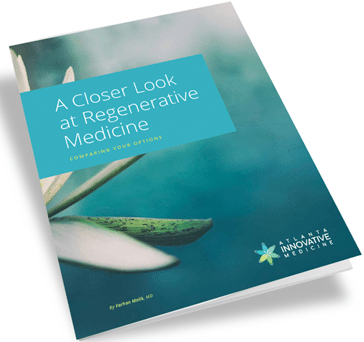30 Oct Winter’s Grip: Tips to Alleviate Joint Pain in Cold Weather
By Farhan Malik, MD
Atlanta Innovative Medicine
Do you find yourself bracing for the inevitable discomfort that winter can bring—dreading joint pain in cold weather year after year?
The winter months can be harsh on your joints, and while you may not be in a position to remove yourself from the cold entirely, there are steps you can take to reduce your body pain due to cold weather. Because, alas, we are not all able to be Florida snowbirds!
In this blog post, we’ll discuss some of the potential physiological changes that occur in certain weather conditions, current research demonstrating a connection between meteorological changes and joint pain severity, and tips for alleviating and avoiding increased joint pain in cold weather.

Can Cold Weather Cause Joint Pain?
While cold weather complaints are often a lighthearted nod to the familiar discomfort of winter, joint pain in cold weather is very real and troublesome for many individuals with musculoskeletal injuries and chronic joint conditions.
Cold weather may not cause joint pain, but it can make joint pain worse. If you ever feel that your bones hurt when cold or if you experience knee pain in cold weather, you likely already have a joint injury or chronic condition—it is simply being exposed or exacerbated by cold weather conditions.

How Cooler Weather Affects Your Spine and Joints
While numerous studies have established a strong correlation between spine and joint pain severity and changes in temperature, humidity, and barometric pressure, the precise science behind these changes is not entirely understood.
However, considering some of the most heavily affected musculoskeletal conditions—osteoarthritis, rheumatoid arthritis, and fibromyalgia—there are several theories as to how certain conditions adversely affect the body to heighten joint pain in cold weather. First it’s important to understand what causes joint pain.
Osteoarthritis joint pain is caused primarily by the degeneration of cartilage and bone-on-bone contact, rheumatoid arthritis pain by inflammation, and fibromyalgia pain by impacted neural pathways.
Cold weather involves several meteorological shifts—namely lower temperatures and shifts in barometric pressure (which is closely tied to humidity)—both of which are theorized to cause physiological changes that directly affect bone-on-bone pain, inflammation, or neural disruptions.
One theory is that muscles, bones, and tendons contract in cold temperatures, causing discomfort and stiffness. Another is that synovial or joint fluid, which lubricates the joints, thickens in cold weather, resulting in limited joint mobility and further increasing arthritic joint pain in cold weather.
The Role of Barometric Pressure
Perhaps the strongest, most commonly cited reason for joint pain in cold weather is the drop in barometric pressure. This decreased pressure can cause tissues in the body to swell slightly, increasing the pressure on joints and exacerbating pain.
Additionally, particularly when it comes to Fibromyalgia patients, some experts believe changes in barometric pressure can indirectly increase pain: by boosting stress levels—as shifts in weather patterns have been shown to do—pressure changes can heighten sensitivity to pain, or increase perceived pain levels.
While you can’t easily avoid barometric pressure changes, you can help yourself better prepare by keeping a barometer handy. Fortunately, in today’s age, you can keep one right in your pocket—there are numerous apps, like this one, that provide real-time updates on atmospheric pressure, allowing you to plan your activities and supplemental self-care easily and efficiently.

Wellness Self-Care Tips for Colder Months
No one deserves to live in chronic pain—and that includes seasonal joint pain. Fortunately, there are several steps you can take to support your body through the changes, both preventing and relieving joint pain in cold weather.
How Can I Protect My Joints Naturally?
When we say it’s possible to manage joint pain in cold weather, we don’t just mean taking a couple of pain pills when the barometer indicates heavy fluctuations. We mean integrating natural lifestyle practices that promote safe movement, hydration, and nutrition.
Regular Activity
Cold weather often tempts us to hibernate indoors, but maintaining an active lifestyle is vital for joint health. Regular physical activity has several benefits that can help ease joint pain in cold weather.
Exercise promotes better circulation, which helps transport nutrients to the joints, remove waste products, and reduce inflammation.
By strengthening the surrounding muscles, exercise provides your joints with better support which can help alleviate some of the stress on them and balance out the strain caused by cold weather. And, by improving flexibility and range of motion, exercise can also help prevent joints from becoming excessively stiff in cold temperatures.
Proper Hydration
It’s easy to overlook hydration during the colder months when the body’s signs of thirst are less obvious, but staying hydrated remains critical for all aspects of your health, including that of your joints.
Proper hydration helps lubricate your joints and makes it easier for them to move, reducing friction and the related joint pain.
Plus, hydration can significantly improve your overall wellbeing and enable you to engage in physical activity which is also important for managing joint pain in cold weather.

Diet & Nutrition
Eating a balanced diet rich in nutrients is essential for overall health, and therefore, has a significant impact on joint health as well.
A well-balanced diet that includes a variety of fruits, vegetables, lean proteins, and whole grains provides essential nutrients that support the body’s ability to repair itself and manage chronic pain conditions like arthritis. By proactively strengthening the body, you can help prevent increased damage and joint pain in cold weather.
Foods rich in omega-3 fatty acids, such as fatty fish like salmon, flaxseeds, chia seeds, and walnuts, have anti-inflammatory properties and can help reduce joint inflammation. Because inflammation is one of the causes of joint pain in cold weather, integrating more omega-3s into your diet can help you alleviate pain and promote joint comfort during the winter season.
Supplementation
There are numerous supplements that can help support and strengthen your musculoskeletal system and reduce the severity of joint pain in cold weather. Some of the most effective and widely prescribed supplements for strengthening the joints and alleviating joint pain include S-adenosyl-methionine (SAM-e), curcumin, glucosamine and chondroitin, and vitamins D and K.
An anti-inflammatory compound produced naturally within the body, SAM-e helps manage inflammation and protect cartilage; and it has been shown to help substantially relieve pain in patients with osteoarthritis.
Though studies are limited, glucosamine and chondroitin have been shown to work together to relieve knee osteoarthritis in various patients, and it has become one of the most popular remedies for knee pain due to cold weather.
Curcumin, a compound found in turmeric, is known for its anti-inflammatory and antioxidant properties, making it a popular supplement for countless inflammatory issues, including chronic joint pain.
Vitamins D and vitamin K are crucial for bone health and cartilage structure, supporting the strength and integrity of your joints. For those with a deficiency, supplementing these vitamins could be very impactful in managing joint pain.
How do I keep my joints warm in the winter?
Proper clothing and warm-up techniques become even more crucial when avoiding worsened joint pain in cold weather.
By dressing warmly with layers and quality winter attire and maintaining a comfortable body temperature, you can help prevent cold temperatures from causing your muscles to contract and your joints to become stiff.
When you warm up before any physical activity, your body gradually increases its core temperature. This helps improve muscle flexibility which not only prepares your joints for movement and reduces the risk of injury but also enhances blood flow to your muscles and joints, making them more responsive and generally less prone to discomfort.

Subscribe for Expert Insights and Our Ebook
A Closer Look at Regenerative Medicine: Comparing Your Options Learn about treatment options like Platelet Rich Plasma (PRP), Prolozone Therapy, and Stem Cell Therapy.

Proactive Steps: Visit Atlanta Innovative Medicine
While common, joint pain in cold weather is not normal. If you find that joint pain persistently arises or worsens in the colder months, it’s likely that you have some sort of musculoskeletal damage that needs addressing.
Fortunately, you are not alone in managing this pain. At Atlanta Innovative Medicine, we specialize in nonsurgical orthopedic treatments and pain management; and using an integrative approach that combines physical therapy, chiropractic care, and regenerative medicine, we help patients not only manage but heal the cause of their pain for relief that lasts far beyond a single winter season.
Whether arthritic pain that’s aggravated by cold-weather stiffness, nerve pain that flares in a chill, or undiagnosed aches that intensify every winter, our dedicated team of pain specialists will help you get to the root of your pain, tailoring a treatment that will have you feeling your best no matter the season.
While winter’s grip on our joints can pose a challenge, it does not make pain-free living impossible. By understanding the physiological impacts of cold weather, practicing counteractive self care, and proactively seeking professional orthopedic care, you can help yourself avoid joint pain in cold weather and stay well all year long.
Your health and wellbeing deserve to be your priority. Your joints deserve your attention. Contact Atlanta Innovative Medicine today to learn how we can help you strengthen your joints and take control of your pain.
Call 770.416.9995 or click the button below to schedule your appointment with AIM today.
Quizzes
Are you a candidate for Regenerative Medicine?
Regenerative medicine can be an effective therapy and treatment option for lasting pain relief for a variety of conditions like osteoarthritis of the knee, hip or shoulder; ACL or meniscus tears; tennis or golfer’s elbow; chronic neck and back pain; and more.
Is it right for you and your condition? Take 1 minute to answer a few “yes or no” questions that help to assess if you might be a candidate for PRP, stem cell or other nonsurgical regenerative treatments.
Are You a Stem Cell Candidate for Your Joint or Spine Damage?
Are you a candidate for Platelet Rich Plasma (PRP) Therapy?
Do I have nonsurgical options for my injured or aging joints?
Take the Pain Medications Risk Quiz

Regenerative Medicine.
Reimagined
- Advanced hybrid therapies, including Mesenchymal Stem Cell therapy combined with different mechanisms of action that synergistically come together to support ultimate healing
- More powerful PRP that’s customized, amplified and personalized
- Therapies delivered by an experienced, compassionate team comprised of multidisciplinary experts in traditional and alternative medicine working as your team: Medical Doctors, Nurse Practitioners, Physiotherapists and Chiropractors
- Advanced training through the American Academy of Orthopedic Medicine, the American Osteopathic Association of Prolotherapy Regenerative Medicine, and more
All content of this page is for informational purposes only and is not intended to serve as a substitute for the consultation, diagnosis, and/or medical treatment of a qualified physician or healthcare provider. Individual results may vary. Your medical professional can explain all the risks and potential benefits of any therapy based on your specific circumstances. At this time regenerative therapies are not FDA approved. Neither Atlanta Innovative Medicine nor its physician affiliates promise regenerative therapies as a cure for any condition, disease, or injury.
Other Atlanta Areas We Service:
© 2024 Atlanta Innovative Medicine, LLC. All Rights Reserved. AIM Scholarship Opportunity








